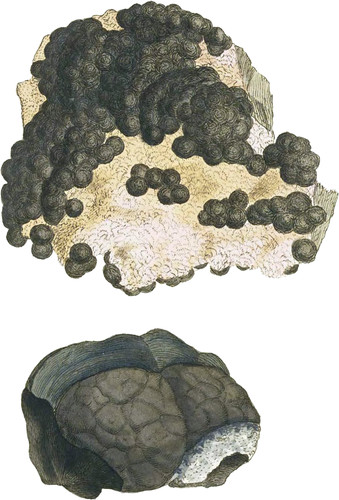 Enlarge
Enlarge
Exotic Mineralogy
Native Arsenic
- Syn.
- Arsenic natif, Haüy, Tabl. 108. Traité 4. 220.
- Arsenic testacé, Régule d’arsenic natif, De Born, 2. 94.
- Gediegen arsenik, Emmerl. 2. 548.
The facility with which some metals oxidize when exposed to damp or the atmosphere, has been urged as a reason for their not having been discovered in an uncombined state. Is it not then a curious fact, that Arsenic, one of the most easily oxidized metals, should be found in the metallic state and nearly pure? It has, however, been long known, and is found in the Hartz, Saxony, Freyberg, France, &c.
The upper figure is taken from a specimen in the British Museum; the globular masses of Arsenic rest upon Quartz, and are prettily relieved by flesh coloured Carbonate of Iron or Pearl-spar, The other is a small specimen of the more common kind, usually called testaceous, from the shell-like form of the concentric coats of which it is composed; its gangue is Carbonate of Lime. Native Arsenic agrees with the artificial in most of its characters, but appears to be less easily acted upon by the atmosphere; the texture is generally fine granular, but in some specimens the grains are sufficiently large to show a laminated fracture, and are disposed in ramifications through the mass, the colour when fresh broken is grey a metallic lustre, but the surface soon becomes of a dark and dull brown. Its peculiar odour is rendered perceptible by friction, and it is known from the ores of Arsenic, by being wholly volatile when heated.

